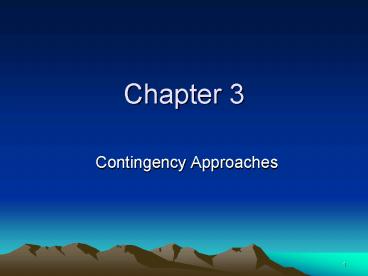Contingency Approaches - PowerPoint PPT Presentation
1 / 14
Title:
Contingency Approaches
Description:
Follower Characteristics. Appropriate Leader Style. Low readiness level. Moderate readiness level ... a situational characteristic that counteracts the ... – PowerPoint PPT presentation
Number of Views:102
Avg rating:3.0/5.0
Title: Contingency Approaches
1
Chapter 3
- Contingency Approaches
2
Chapter Objectives
- Understand how leadership is often contingent on
people and situations. - Apply Fiedlers contingency model to key
relationships among leader style, situational
favorability, and group task performance. - Apply Hersey and Blanchards situational theory
of leader style to the level of follower
readiness. - Explain the path-goal theory of leadership.
- Use the Vroom-Jago model to identify the correct
amount of follower participation in specific
decision situations. - Know how to use the power of situational
variables to substitute for or neutralize the
need for leadership.
3
Ex. 3.1 Comparing the Universalistic and
Contingency Approaches to Leadership
Outcomes (Performance, satisfaction, etc.)
Leadership Traits/behaviors
Universalistic Approach
Leader
Style Traits Behavior Position
Contingency Approach
Outcomes (Performance, satisfaction, etc.)
Needs Maturity Training Cohesion
Task Structure Systems Env.
Situation
Followers
4
Contingency Approaches
Contingency approaches approaches that seek to
delineate the characteristics of situations and
followers and examine the leadership styles that
can be used effectively
Fiedlers contingency model a model designed to
diagnose whether a leader is task-oriented or
relationship-oriented and match leader style to
the situation
5
Ex. 3.2 Metacategories of Leader Behavior and
Four Leader Styles
High
High Task-Low Relationship
High Task-High Relationship
TASK BEHAVIOR
Low Task-Low Relationship
High Relationship -Low Task
Low
Low
High
RELATIONSHIP BEHAVIOR
6
Situational Theory
Hersey and Blanchards extension of the
Leadership Grid focusing on the characteristics
of followers as the important element of the
situation, and consequently, of determining
effective leader behavior
7
Ex. 3.4 Hersey and Blanchards Situational Theory
of Leadership
Follower Characteristics
Appropriate Leader Style
Low readiness level Moderate readiness
level High readiness level Very high
readiness level
Telling (high task-low relationship)
Selling (high task-high relationship)
Participating (low task-high rel.)
Delegating (low task-low relationship)
8
Path-Goal Theory
A contingency approach to leadership in which the
leaders responsibility is to increase
subordinates motivation by clarifying the
behaviors necessary for task accomplishment and
rewards
9
Ex. 3.5 Leader Roles in the Path-Goal Model
Increase Rewards
Path Clarification
Leader learns followers needs
Leader defines what follower must do to attain
work outcomes
Leader clarifies followers work role
Leader matches followers needs to rewards if
work outcomes are accomplished
Follower has increased knowledge confidence to
accomplish outcomes
Leader increases value of work outcomes for
follower
Follower displays increased effort and motivation
Organizational work outcomes are accomplished
10
Ex. 3.6 Path-Goal Situations and Preferred Leader
Behaviors
Situation
Leader Behavior
Impact on Follower
Outcome
Supportive Leadership
Followers lack self-confidence
Increases confidence to achieve work outcomes
Directive Leadership
Increased effort improved satisfaction and
performance
Ambiguous job
Clarifies path to reward
Achievement-Oriented Leadership
Lack of job challenge
Set and strive for high goals
Participative Leadership
Clarifies followers needs to change rewards
Incorrect reward
11
The Vroom-Jago Contingency Model
A contingency model that focuses on varying
degrees of participative leadership, and how each
level of participation influences quality and
accountability of decisions
12
Ex. 3.7 Five Leader Decision Styles
Area of Freedom for Group
Area of Influence by Leader
Delegate
Decide
Consult Individually
Consult Group
Facilitate
13
Substitute and Neutralizer
Substitute a situational variable that makes
leadership unnecessary or redundant
Neutralizer a situational characteristic that
counteracts the leadership style and prevents the
leader from displaying certain behaviors
14
Ex. 3.10 Substitutes and Neutralizers for
Leadership































